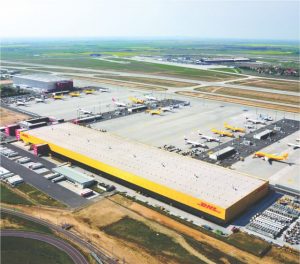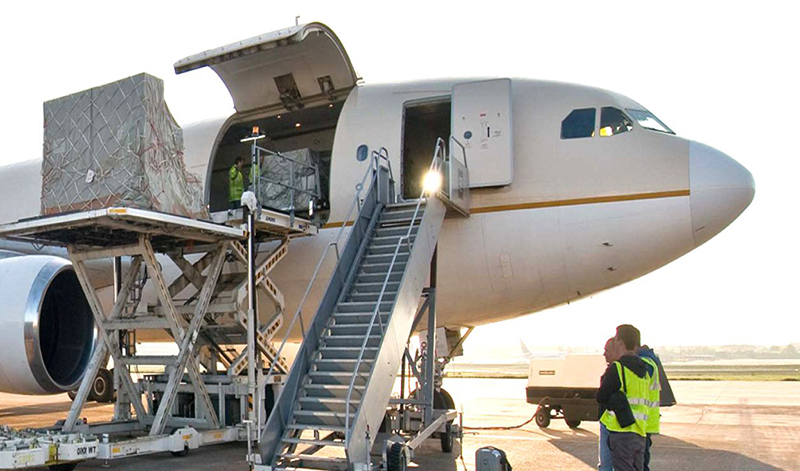CSQ Tool: Designed to raise new global standards for the air cargo industry
The global air cargo market is expected to reach a valuation of US$130.12 billion by the end of 2025. During the forecast period of 2017 and 2025, the global market is expected to surge at a CAGR of 4.9%.
Prior to the 90s, customer satisfaction was rarely proposed as the key organizational goal, however, in recent years, it has become a lead indicator that predicts future consumer behavior.
As many industry players mature, competitive advantage through high quality service has increasingly been an important weapon for any cargo business survival.
Keeping this in mind, the air cargo industry has adopted firm quality management approaches to ensure customer satisfaction and quality of service is maintained at all times.
As the prospects of reaching out to global markets becoming more and more of a reality, the demand for air cargo movements will continue to grow as part of an expanding logistics system that emphasizes higher processing speeds, greater efficiency, more specialized customer services, time definite delivery and reduced costs.
Market size
The air freight segment of the global air cargo market is estimated to bring in revenues of nearly US$98.81 billion by the end of 2020.
Factors such as rapid development of businesses, building of cargo hubs, and rapid growth of the e-commerce business model are expected to drive the prospects for growth in this market segment.
The global air cargo market is expected to reach a valuation of US$130.12 billion by the end of 2025. During the forecast period of 2017 and 2025, the global market is expected to surge at a CAGR of 4.9%.
The global air cargo market has been segmented on the basis of type, service, end-user, destination, and geography. On the basis of type, the market is segmented into air freight and air mail. Out of these, the air freight segment is likely the lead the global market in the coming years. The market is further segmented on the basis of service, the service includes express and regular.
Cargo yields are expected to improve by 4.0% in 2018 (slower than the 5.0% in 2017). While restocking cycles are usually short-lived, the growth of e-commerce is expected to support continued momentum in the cargo business beyond the rate of expansion of world trade in 2018.
Cargo revenues will continue to do well in 2018, reaching $59.2 billion (up 8.6% from 2017 revenues of $54.5 billion), analysts said.
CSQ Tool
The International Air Cargo Association (TIACA) has recently developed a new online Cargo Service Quality (CSQ) tool to help improve visibility and facilitate global standards across the air cargo supply chain – a step towards providing shippers with the ability to view the quality of service delivered in the air cargo supply chain.
“Cargo Service Quality (CSQ) is a special measure that has been initiated by The Inter-national Air Cargo Association (TIACA) with a vision of driving global standards and raising the profile of air cargo. The ultimate aim is to map the Cargo Service Quality delivery by each player in the cargo supply chain. The launch of the 1st phase of implementation will assess the quality of the services offered by the cargo terminal operators (CTO)’s to the customers (freight forwarders),” said Sanjiv Edward, TIACA’s board director and Head of Cargo business at Delhi, in an email interview with Air Cargo Update.
The initiative was launched at TIACA’s 2017 Executive Summit in Miami, and comes after a year of research undertaken by TIACA board members – led by chairman Sanjiv Edward himself, and Cheemeng Wong, senior vice president of cargo services at SATS.
Edward says: “In my interactions with shippers it has been reaffirmed that the lack of visibility and absence of uniform global standards results in air freight business deals being limited by cost considerations, lack of product improvements, and perceived lack of value for money.”
CTOs are being assessed in the areas of process, technology, facilities, regulators, general airport infra-structure, and others. The project is being driven with an online tool launched by TIACA, which provides 100 percent transparency, and all the assessments are recorded in the system without any manual inter-vention.
“We have recently concluded the pilot phase of the CSQ project with 18 cargo terminals (CT)’s as participants. The response has been overwhelming with 179 freight forwarders completing the assessments”.
Facilitating global standards
Participants will be able to fill out an online ‘Cargo Quality Assessment Form’ either every quarter, or every six months, and will have access to a customized ‘Quality Dashboard’. Key benefits of taking part include gap analyses in order to identify strength and improvement areas, and best practice sharing.
“Firstly, it improves visibility for CTOs since they will have the ability to see customer feedback on all service components. Additionally, each of the 51 questions will give them an in-depth understanding on the areas in need of improvement.
“Also post the pilot phase i.e., from next assessment, the global launch will happen and different CTs around the globe will be able to see at an aggregate level their quality score compared to other CTs. This healthy practice will create an environment, which will be conducive for driving the service quality level up.”
For the recently concluded pilot phase, the results of assessments for a cargo terminal has been shared with that respective cargo terminal “only as we wish to give an opportunity of improvement for the cargo terminals before the next assessment. However even in this pilot phase the participating cargo terminals have been provided with visibility on average and highest category scores.”
Integrating quality aspect
The ultimate aim of CSQ is to integrate the quality aspect in the complete air cargo supply chain. As briefed earlier, in the first phase customers, freight forwarders, are assessing the services offered by CTOs.
Going forward the services offered by the freight forwarders will also be assessed. With the visibility of CSQ scores, shippers will have the ability to choose based on the level of quality they desire on the performance of freight forwarders, airlines, and cargo terminals. This will help shippers in planning the logistics in the most efficient way.
“CSQ is a special online tool that integrates the quality aspect all along the air cargo supply chain in an online platform. CSQ provides the participant with the visibility of their performance and their comparison with the best in industry. With the scores split into categories the areas of improvement and opportunities of improvement can be specifically pinpointed,” Edward said.
 Unavailability of a uniform cargo quality assessment tool triggers the need to have an online solution to measure the level of quality delivered along the entire air cargo supply chain.
Unavailability of a uniform cargo quality assessment tool triggers the need to have an online solution to measure the level of quality delivered along the entire air cargo supply chain.
The end results facilitate global rating and rank for the participant based on the feedback given by the customers.
The outcomes from these results can facilitate the following, but is not limited to:
1. Benchmark parameters;
2. Gap analysis – identification of strength and improvement areas;
3. Visibility of service quality of other operators;
4. Optimization of investments
5. Sharing the best practice
Rate and review
Rating and ranking is based on the answers submitted by the customers through an online portal. The questions for the assessment have been designed in the various categories and they cover all the processes and the interfaces that form part of the air cargo supply chain.
With total of 51 questions split into the fields/category of process, technology, regulators, general airport infrastructure, and facilities, all the elements required for the processing of cargo are covered. Each and every element of the above mentioned fields are being assessed in terms of quality of service being delivered.
The questions are objective in nature with nil element of subjectivity in them. Detailed analysis of the assessment not only tells the participant their stand in the industry but also let them know the key areas of concern/improvement as perceived by the customers.
“With the vision to integrate quality aspect all along the supply chain of air cargo, going forward in the long run, the performance of the participant in the CSQ scores will not only determine the quantum of business being handled by them but will also provide them the ability to benchmark their own performance with the industry best.
“Shippers will have the ability to choose the service provider based on the quality of service delivered by them through CSQ score and for the first time the cargo players will have the opportunity to be rewarded and recognized for their high level of quality service delivery”.
Business and operational benefits
The objective of the CSQ tool is to continuously improve the levels of service quality delivered in the supply chain. The TIACA Quality Council, headed by Edward and comprises of Cheemeng Wong, Amar More, Steven Polmans and Ramesh Mamidala, will be constantly looking at feedback and areas of improvement to enhance the effectiveness of the tool.
The process for collecting feedback from the pilot participants has already started and useful suggested modifications will surely be implemented before the global launch.
“With the outcome of the assessment, cargo terminals can work upon the areas of improvement which will not only raise the quality bar in the processes they follow but will also simplify the operational processes and hence will bring the operational excellence. Optimization of investments and resource allocation can be planned as per the voice of the customer reflected in the CSQ scores”.
With the aim to be the best in industry cargo terminals will take their performance to the next level, which has, potential to provide them with incremental business and expand their customer database.
The days are not far when the air cargo business deals will be determined on the quality scores achieved by the stakeholders not on the cost consideration, which is currently determining the deals.
Quality improvement starts with quality measurement and TIACA has already launched the CSQ to measure the quality score for the services delivered.
Embracing the change
TIACA recently rolled out a new look with a fresh logo and redesigned websites to “underpin its new vision supporting the development of an efficient, modern and unified air cargo industry”.The rebranding of our association goes hand in hand with the need to appeal to and continue to support a rapidly evolving global air cargo industry.
“From disruptive innovation, to Blockchain and Big Data, as well as new entrants who are changing the face of the competition, means we are having to rethink the way we conduct ourselves and our businesses in order to stay ahead in the game, said Sebastian Scholte, TIACA Chairman in an email interview with Air Cargo Update.
“Our new logo embraces a fresh, engaging look that better reflects our new vision to show we are forward thinking and will do all we can to represent, support, and inform every element of an efficient, modern, and unified global air cargo industry. I have often emphasized the need for us to attract and retain the next generation of logistics leaders.
“Our new vision and mission sends a message that we are ready to embrace the younger demographics and stay relevant in a business landscape where their needs, as well as ours, are changing all the time. It represents a stronger, more focused, and a more agile Association”.
 In recent months TIACA has partnered up with a number of organizations and associations around the world, and is acting as a unifying platform in which supply chain stakeholders from everywhere can network, learn from each other, and share best practice.
In recent months TIACA has partnered up with a number of organizations and associations around the world, and is acting as a unifying platform in which supply chain stakeholders from everywhere can network, learn from each other, and share best practice.
“We have also been reaching out to new regions to increase our visibility as well as explore how we can support and represent the interests and goals of emerging air cargo hotspots.TIACA has been supporting and championing the air cargo industry for over 28 years, and we are determined to continue doing so by staying engaged, relevant, and valuable to our existing (and future) members,”explains Sebastian.
The launch comes at the perfect time, with Air Cargo Forum in Toronto, Canada this year only just around the corner, where TIACA will be bringing together stakeholders from across the global supply chain like never before.
Vladimir Zubkov, TIACA’s Secretary General told Air Cargo Update, “Before writing these notes, I went to the web and checked how many companies ever changed their logos. Remarkably – a lot! Sometimes – radical changes, sometimes only cosmetic, but there is always a reason, often reflecting changes in the strategy, customers base coverage and the environment in which the company works.
“TIACA’s reason is no different. Early last year we started a campaign for expansion of TIACA’s regional coverage, adding new members, partners and Board members from Africa, Asia, and Latin America. We are becoming more global. That’s why the new logo includes a globe drawn using a 3D version of the kinetic lines in the original version.The emergence of new challenges and technologies firmly making their way into the air cargo industry, like blockchain, backbone, IT, and data exchange innovations simply can’t leave us in the era of flat designs and plain texts. So, now the TIACA acronym is more imaginative, with the final A drawn as the wing of an airplane. We have not changed much the color scheme, it simply has been adapted from the original, introducing a stronger shade of blue. It’s for consistency”.
The new look of the logo is coming hand in hand with the redesigned websites, which is reflecting the TIACA’s new vision and new developments in supporting an efficient, modern, and unified air cargo industry.


